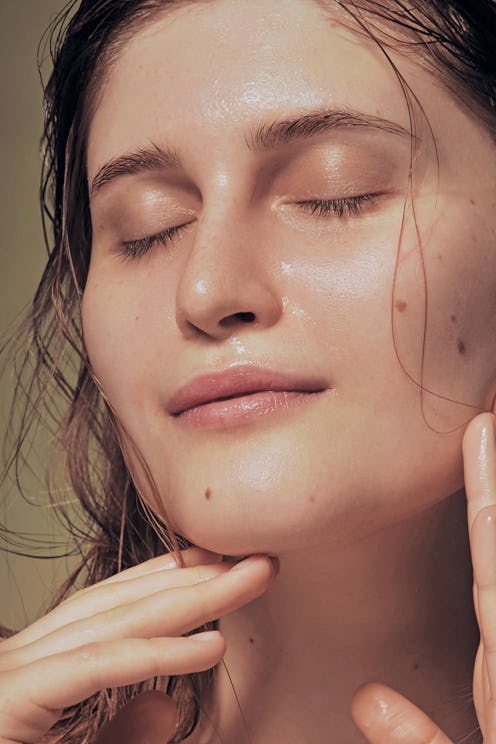(Skin)
Do Certain Products Really Work Better On Damp Skin?
Experts answer one of the most-asked questions.

Every time I get out of the shower, I worry about quickly putting on body lotion because I’ve been told by some skin care experts that damp skin is best for absorption. But what exactly constitutes as “damp”? If I don’t towel-off enough, my skin is so wet that it mixes with the lotion and creates a strange soapy texture. Other times, I pat myself so dry that I worry I’m no longer damp enough to reap the full benefits of the body moisturizer.
There’s no rulebook for skin care and body care, although I wish there was (it would make our lives a whole lot easier). Instead, the American school system chooses to teach us about the Pythagorean theorem and the powerhouse of the cell. According to family nurse practitioner certified in family medicine and dermatology, Dr. Jodi LoGerfo, DNP, APRN, FNP-BC, “Some products are better absorbed by your skin when it's damp,” including face oils, moisturizers, and serums.
To find out why damp skin is ideal when using certain products, I consulted Dr. LoGerfo, along with board-certified dermatologist Dr. Julia Schwartz, M.D., celebrity esthetician and skin expert Renée Rouleau, and beauty chemist Benjamin Knight Fuchs, R. PH. Read on to find out the ingredients that work best on moist skin, plus their take on the viral skin flooding TikTok trend.
What Is Damp Skin Vs. Wet Skin?
While it might seem obvious, damp skin lands somewhere between wet and dry. According to Dr. Schwartz, “Damp skin falls in between completely wet and completely dry skin – it still has a bit of moisture from exposure to water but isn’t dripping wet.” It’s really a question related to texture and the quantity of water on the skin. According to Fuchs, “Damp skin is moistened with a slight wetness versus wet skin, which has lots of water on it, to the point of dripping.” Basically, you know your skin is wet when you hop out of the shower without towel drying and your bathroom floor resembles a water park locker room.
Why Is Damp Skin
It’s important to keep in mind that the point of an effective skin care routine is not all about the top layer of the skin. Fuchs explains that the surface of our skin is composed of dead protein-filled cell shells called corneocytes and that a good regimen addresses the viable (i.e., living) cells that are located relatively deep in the tissue. “When skin is damp, these surface corneocytes spread out, opening pores and leading to the formation of channels that allow penetration of ingredients to these deeper layers where they can impact the viable cells,” he explains. In layman’s terms, when skin is damp, it is thought to be more permeable.
According to Rouleau, “This also means that when your skin is damp, and you apply a serum (a product formulated with a smaller molecule), it may absorb deeper into the skin to increase its efficacy. When a thicker product (a larger molecule formula) is applied to damp skin, it creates an occlusion over the skin to hold that water dampness into the skin, which helps keep a stronger, healthier moisture barrier.” She suggests following The Golden Minute Rule, meaning that you should apply your first skin care product within one minute of cleansing while the skin is still damp to prevent transepidermal water loss.
What Skin Care Ingredients Work Best With Damp Skin?
As far as ingredients go, “active ingredients such as vitamins, minerals, amino acids, fatty acids, and select phytonutrients that living cells in the lower layers of the skin will respond to work best on damp skin,” explains Fuchs.
However, in the big wide world of beauty products, it really just depends. When the skin is moist, products like moisturizers can be better absorbed as their penetration is enhanced. “Water acts like magnets, attracting water,” says Rouleau. “So it’s best to leave the skin damp with an alcohol-free toner or essence and then apply a serum with humectants that contain glycerin, hyaluronic acid, sodium hyaluronate, sodium PCA — all work synergistically to encourage plump, super-hydrated skin.”
What Skin Care Ingredients Should Be Reserved For Dry Skin?
Per Fuchs, ingredients designed to soften the skin surface (e.g., oils, silicone, propylene glycol, glycerin, etc.) and that do not need to change living cell chemistry can be used on dry skin. This makes sense since you’re only targeting the top layer with these. Dr. Schwartz also suggests that people apply retinoids to dry skin to help minimize irritation and ensure the proper amount of absorption of the product.
Where Does Damp Skin Come Into Play With Skin Flooding?
Skin flooding is a hydration technique that involves layering or piling on multiple products one by one on the skin to boost hydration and moisture. “Water-trapping benefits of this technique can be maximized when the skin is damp. Also, because damp skin opens pores, layered moisturizing ingredients can penetrate past the stratum corneum, allowing for deeper effects,” says Fuchs. Applying moisturizer to damp skin, given its potential to help increase hydration, could be a beneficial addition to a skin flooding routine. “If you’re interested in skin flooding, before adding new products to your skincare routine, I recommend consulting your dermatologist or a licensed provider through a platform like Ro, who can advise you on if skin flooding is right for you,” says Dr. Schwartz.